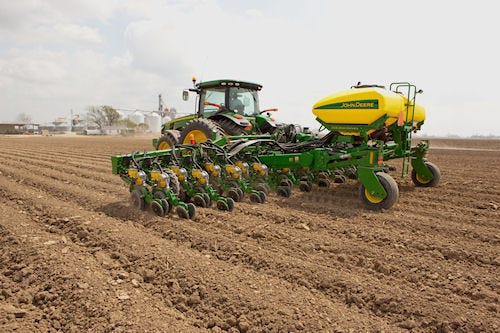
John Deere has introduced a pair of twin-row planters in the Mid-South and Southeast for corn, soybean, cotton and peanut producers.
Douglas Toepper, product specialist for Deere's Seeding Group, says the current line up consists of the 1700 TR 6X2 "our peanut machine" which is six twin rows on either 36- or 38-inch centers; or a 1720 CCS TR 12X2 which is a 12 twin-row planter on 36- or 38-inc rows.
Highlights for the 1700 TR, include 2-bu. hoppers (4 bu. seed per row), pneumatic down force, SeedStar monitoring, optional dual vacuums, variable rate drive and granular insecticide capability.

Delta and Southern U.S. cotton, soybean, corn and peanut growers have a pair of twin-row planter choices from John Deere this year. The 1700 TR 6X2 and the 1720 CCS TR 12X2 (shown) represent the company's initial forays into twin-row configurations.
The 1720 CCS TR 12X2 features Central Commodity System seed delivery for 100-bushel capacity, bulk filling ability and easy clean-out. There's also row-unit down pressure and hydraulic steering for the chassis lift to prevent "bulldozing" at the end of the rows, Toepper explains
The TR row unit used on these machines allows twin rows to be placed as close as 7.5 inches apart while using many of the design benefits of the proven MaxEmerge XP and Pro-Series XP.
The 1720 TR planter gives producers flexibility to plant both single and twin rows with the same machine and switching between the two configurations is simple and quick.
The hydraulic steering assist on the 1720 TR steers the wheels in the opposite direction of those of the tractor when in reverse. The system is calibrated to steer the lift assist wheels to the ideal angle when turn and guides the planter from a position sensor mounted to the tractor's front axle. This helps prevent lift assist wheels from casting or spinning when the direction is changed from forward to reverse -- reducing disruption to the seed bed.
About the Author(s)
You May Also Like




